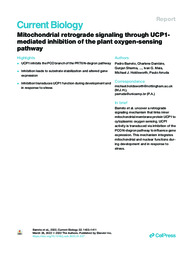Mitochondrial retrograde signaling through UCP1-mediated inhibition of the plant oxygen-sensing pathway.
Mitochondrial retrograde signaling through UCP1-mediated inhibition of the plant oxygen-sensing pathway.
Autoria: BARRETO, P.; DAMBIRE, C.; SHARMA, G.; VICENTE, J.; OSBORNE, R.; YASSITEPE, J. E. de C. T.; GIBBS, D. J.; MAIA, I. G.; HOLDSWORTH, M. J.; ARRUDA, P.
Resumo: SUMMARY. Mitochondrial retrograde signaling is an important component of intracellular stress signaling in eukaryotes. UNCOUPLING PROTEIN (UCP)1 is an abundant plant inner-mitochondrial membrane protein with multiple functions including uncoupled respiration and amino-acid transport1,2 that influences broad abiotic stress responses. Although the mechanism(s) through which this retrograde function acts is unknown, overexpression of UCP1 activates expression of hypoxia (low oxygen)-associated nuclear genes.3,4 Here we show in Arabidopsis thaliana that UCP1 influences nuclear gene expression and physiological response by inhibiting the cytoplasmic PLANT CYSTEINE OXIDASE (PCO) branch of the PROTEOLYSIS (PRT)6 N-degron pathway, a major mechanism of oxygen and nitric oxide (NO) sensing.5 Overexpression of UCP1 (UCP1ox) resulted in the stabilization of an artificial PCO N-degron pathway substrate, and stability of this reporter protein was influenced by pharmacological interventions that control UCP1 activity. Hypoxia and salt-tolerant phenotypes observed in UCP1ox lines resembled those observed for the PRT6 N-recognin E3 ligase mutant prt6-1. Genetic analysis showed that UCP1 regulation of hypoxia responses required the activity of PCO N-degron pathway ETHYLENE RESPONSE FACTOR (ERF)VII substrates. Transcript expression analysis indicated that UCP1 regulation of hypoxia-related gene expression is a normal component of seedling development. Our results show that mitochondrial retrograde signaling represses the PCO N-degron pathway, enhancing substrate function, thus facilitating downstream stress responses. This work reveals a novel mechanism through which mitochondrial retrograde signaling influences nuclear response to hypoxia by inhibition of an ancient cytoplasmic pathway of eukaryotic oxygen sensing.
Ano de publicação: 2022
Tipo de publicação: Artigo de periódico
Unidade: Embrapa Agricultura Digital
Palavras-chave: Arabidopsis thaliana, Expressão gênica, Gene expression, Gene overexpression, Hypoxia, Mitocôndria, Resposta fisiológica
Observações
1 - Por padrão são exibidas publicações dos últimos 20 anos. Para encontrar publicações mais antigas, configure o filtro ano de publicação, colocando o ano a partir do qual você deseja encontrar publicações. O filtro está na coluna da esquerda na busca acima.
2 - Para ler algumas publicações da Embrapa (apenas as que estão em formato ePub), é necessário ter, no celular ou computador, um desses softwares gratuitos. Sistemas Android: Google Play Livros; IOS: iBooks; Windows e Linux: software Calibre.
Acesse outras publicações
Acesse a Base de Dados da Pesquisa Agropecuária (BDPA) para consultar o acervo completo das bibliotecas da Embrapa.

